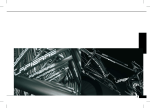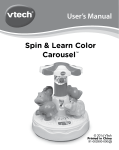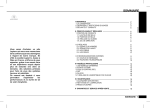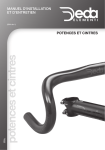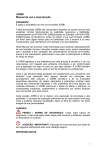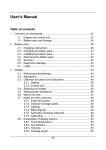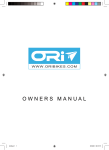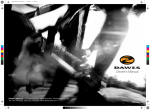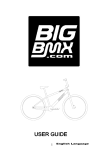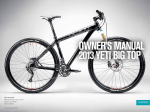Download Lapierre Bike Manual
Transcript
24 - ENGLISH You have just acquired a Lapierre bike and we would like to take this opportunity to thank you for your purchase. Lapierre, based in Dijon, France, since 1946, is pleased to provide you with innovative solutions for enjoyable riding. This manual is designed to help you fully understand your Lapierre bike for an optimal performance. I - WELCOME 1 - ABOUT OUR BIKES 2 - DEFINITIONS AND RESTRICTIONS 3 - SAFETY AND USAGE 2 3 5 II - SETTING 1 - RIDING POSITION 1.1 SADDLE HEIGHT 1.2 SADDLE POSITION 1.3 STEM AND HANDLEBARS 1.4 HEADSET 6 6 6 7 7 2- DRIVETRAIN 2.1 REAR DERAILLEUR 2.2 FRONT DERAILLEUR 2.3 BRAKES 2.4 WHEELS 8 8 9 10 10 3- RECOMMENDATIONS 3.1 TORQUES SPECIFICATIONS 3.2 SUSPENSION FORKS 11 11 11 III - SPECIFIC MODELS 1 - CARBON MODELS 2 - RAID FX 3 - XR 4 - X-CONTROL (FPS+) 5 - ZESTY TR / ZESTY AM / SPICY / FROGGY (OST / OST+) 6 - DH (SLT) 7 - OVERVOLT 8 - E:I SHOCK AUTO 9 - THRU-AXLE ADJUSTMENT 11 12 13 13 14 15 16 17 17 IV - MAINTENANCE 1 - MAINTENANCE SCHEDULE 2 - CLEANING YOUR BIKE 3 - WORN PARTS 18 19 19 V- GENERAL WARRANTY CONDITIONS 20 ENGLISH CONTENTS CONTENTS - 1 I - WELCOME 1 - ABOUT OUR BIKES ENGLISH Lapierre’s R&D headquarters are also located in Dijon, at the main production site. Our engineers are on hand to take your needs as a cyclist into consideration when developing new concepts and ideas. All of the different aspects, from geometries and technologies to materials and components, are closely studied to offer you unparalleled comfort and performance. The members of the R&D department also work closely with the riders from Team Lapierre Gravity Republic (DH) and the Team FDJ.fr (professional road team) in order to benefit from their experiences at the highest levels of competition. Each one of our models is developed with a particular style of riding in mind, and we pay close attention to even the tiniest detail to offer you a top quality product. All of our bikes are individually assembled by a Lapierre specialist, whose signature you’ll find on the Quality Check accompanying your purchase. Lapierre bikes conform to the security standards listed below, as described in the new European norms: - EN14764: “Bicycles used on public highway” - EN14765: “Bicycles for young children” - EN14766: “Mountain bicycles” - EN14781: “Road bicycles” Lapierre bikes are developed for top performance in specific riding conditions, and they can be divided into different categories according to the terrain for which they were created. Not respecting the intended use of the bike can pose potential risks to the rider. When you purchase a Lapierre bike, you are buying the highest quality product that we can offer you. Thank you for your trust, and we look forward to accompanying you on many rides. 2 - WELCOME WARNING PLEASE READ THIS MANUAL CAREFULLY BEFORE USING YOUR BIKE. FOR MAINTENANCE AND SETTINGS FOR COMPONENT PARTS, PLEASE REFER TO THE SUPPLIERS’ MANUALS DELIVERED WITH YOUR BIKE. WARNING FOR YOUR SAFETY, ALWAYS WEAR THE NECESSARY PROTECTIVE GEAR. MAKE SURE YOU HAVE ON APPROPRIATE CLOTHING AND THAT YOU ARE VISIBLE TO AUTOMOBILES. WEARING A HELMET IS STRONGLY RECOMMENDED. IF YOU FALL, MAKE SURE YOU CAREFULLY INSPECT YOUR BIKE BEFORE RIDING AGAIN. IF YOU DETECT A PROBLEM, DO NOT USE YOUR BIKE UNTIL IT HAS BEEN FIXED. CHECK YOUR BIKE BEFORE EVERY RIDE. I - WELCOME 25 31 28 26 27 32 1 33 35 4 30 9 34 3 8 36 20 2 23 20 19 19 18 6 22 17 10 23 21 7 18 17 14 12 11 5 16 21 3 - WELCOME 15 13 29 10 2 - DEFINITIONS FRAME 1 - Top tube 2 - Down tube 3 - Seat tube 4 - Head tube 5 - Chain stays 6 - Seat stays 7 - Bottom bracket 8 - Fork 9- Rear shock absorber (Only on full-suspension MTB) DRIVETRAIN 10- Front / Rear derailleur 11 - Cranks 12- Chainrings 13- Chain 14- Cassette 15- Pedals (depending on the type of bike) 16- Derailleur hanger ENGLISH 24 28 WHEELS 17- Front / Rear hub 18- Spokes 19- Front / Rear rim 20- Tyres 21- Valve 22- Quick release 23- Front / Rear brakes (V-Brake or disc brake depending on the type of bike) COMPONENT PARTS 24- Handlebar 25- Stem 26- Brake levers 27- Shifters 28- Grips 29- Cables 30- Outer cable 31- Saddle 32- Saddle clamp 33- Seat Post 34- Seat Post Clamp 35- Headset 36- Linkage WELCOME - 3 I - WELCOME CONDITION 1 Road: Drop handlebars or Aerobars, calliper brakes, 700c wheels with 20-25c tyres. Riding condition 1 ENGLISH Road cruiser: Similar to road bike but with flat handlebars. Riding condition 1 City: Drop handlebars, 26’’, 28’’ wheels, equipped with bag holders and a permanent light. Riding condition 1 Touring: Flat handlebars, 700 wheels with 32-35c tyres. Riding condition 2 Cross-country MTB: Flat or Riser handlebars, 26’’, 29’’ wheels with large tyres, V-Brake or disc brakes. Front suspension only or front suspension and moderate rear suspension. Riding condition 3 Free ride, Enduro, DH, Dirt MTB: Large tyres, riser bars, long travel suspension. For a more aggressive riding style. All of these models have reinforced frames. Riding condition 4 Warning: Using your bike in riding conditions other than those described above could cause your bike or its component parts to deteriorate prematurely. Lapierre bikes are designed for people weighing up to 100 kg (220 lbs). Exceeding this weight limit could cancel the terms of the guarantee. 4 - WELCOME PAVED SURFACE, TYRES STAY ON THE GROUND WHILE RIDING. CONDITION 2 INCLUDES RIDING CONDITIONS 1 PLUS GRAVEL OR UNEVEN PATHS, TYRES STAY ON THE GROUND WHILE RIDING. CONDITION 3 INCLUDES RIDING CONDITIONS 2 PLUS ALL TYPES OF PATHS. TYRES MAY MOMENTARILY LEAVE THE GROUND. NO JUMPS. CONDITION 4 ALL TYPES OF RIDING. I - WELCOME 3 - SAFETY AND USAGE As with all sports, cycling can involve a number of potentially fatal risks. By taking part in this activity, you are assuming these risks. It is therefore important to know and apply the rules of responsible riding and to properly maintain your bicycle, for your safety and the safety of others. Wearing the proper equipment, such as a helmet, protective eyewear, and gloves, is also strongly recommended. • Always double check your bike before riding it (tighten the handlebars and stem, check the saddle, wheels, and brakes, etc.). It is strongly recommended to establish and respect a periodic maintenance schedule, which will be determined by the frequency and length of your rides, your style of riding, as well as the terrain on which you most often ride. Your Lapierre authorized dealer can help you determine your specific needs. ENGLISH When you acquire your Lapierre bike, it has already been assembled and carefully inspected by one of our authorized dealers. After an initial testing period (4-5 rides), we recommend a visit to your authorized Lapierre dealer for any final adjustments to your bike. They will have the specific tools as well as the information and skills necessary to perform the more complicated adjustments. If, however, you prefer to perform these various adjustments yourself, you will find helpful advice in this manual. • When you are riding on the road, make sure that you are always visible to other vehicles by using reflective products (clothing, reflectors, etc.) and the proper lighting if necessary. Respect the rules of the road in all circumstances. • Never overestimate your abilities, especially in more aggressive styles of riding. Proper training and skill development can reduce many risks. • When you are riding on public roads, always respect the code of conduct and the local bicycle riding laws. For an optimal performance, certain settings will need to be adjusted on your bike before your first ride. This will assure a safe and comfortable ride. WELCOME - 5 II - SETTINGS 1 RIDING POSITION ENGLISH 1.1 SADDLE HEIGHT Every human body is unique, which means that the ratio between your torso, arm length and leg length can vary between people even of the same height. It is important to adjust your saddle to your needs. If the saddle is too high, your hips will rock from side to side in order to pedal, which can cause back pain. If the saddle is too low, pressure is unevenly distributed along your leg and on your knee causing unnecessary pain. In order to find the correct saddle height, use the following steps. With the cranks parallel to the seat tube, take off your shoe and place your heel on the lower pedal. Your leg should be straight, without having to stretch it. This will give the ideal height for riding with shoes and pedalling with the ball of your foot at the pedal axel. When you raise the seat post, do not raise it higher than the “INSERT MINI” or “STOP” indications that are in general engraved at the bottom of the seat post. If this indication is visible while you ride, you can deform the tubes of your frame or even break it, possibly resulting in serious injury. This will also cancel the terms of the warranty. The saddle height can be adjusted with: - A seat post binder bolt - An Allen bolt (always work with the bolt on the right hand side) - Quick release system (in this case, position the lever at a 90˚ angle to the top tube to tighten or loosen the opposed nut, then close the lever to block the system) For XR model: After adjusting the height of your saddle, make sure the seatpost does not interfere with the shock. Operate the shock along its travel (compression) to ensure it does not touch the seatpost. If there is a collision between the shock and seatpost: cut seatpost. Also verify that the insertion depth of the seatpost in the frame is at least 100mm. 1.2 SADDLE POSITION You may suffer some initial discomfort before your body becomes accustomed to sitting on the saddle. However, the position of the saddle may also cause some irritation. To avoid this kind of problem, in general a level saddle position is best. Of course, the saddle can be slightly tilted depending on the body shape of the rider. You can also adjust the fore and aft position of saddle for 6 - SETTINGS WARNING FOR YOUR SAFETY, NEVER RIDE YOUR BIKE WITH THE SEATPOST RAISED ABOVE THE MINIMUM INSERTION MARK. SET-UP II - SETTINGS FOR YOUR SAFETY, RESPECT THE TORQUE SPECIFICATIONS OF THE DIFFERENT COMPONENTS. CHECK YOUR BIKE BEFORE AND AFTER EVERY RIDE FOR PLAY OR VIBRATIONS, WHICH WILL HELP IDENTIFY IF A PART IS NOT TIGHTENED CORRECTLY OR NEEDS REPLACING. comfortable pedalling and the correct back position. When you do find the correct position, the saddle must be securely tightened so that it can no longer move while riding. 1.3 STEM AND HANDLEBARS To adjust the height of the stem: 1 – First loosen the stem expander bolt two or three turns, then tap the top of the stem expander bolt to loosen the stem quill. 2 – Then you can freely adjust the height of the stem, but be careful not to exceed the minimum insertion mark. When you retighten the stem, be sure to respect the torque specifications and to align the stem with the front wheel. If you have a threadless headset, we recommend that you consult your Lapierre authorized dealer who can flip the stem or remove spacers. After making adjustments to the stem, check that the stem is tightened by trying to turn the handlebars left and right while you hold the front wheel between your legs. For your safety, adjust your handlebars so that you can easily access the brake levers and the shifters. For mountain bikes: The shifters should be positioned in the prolongation of your forearms when you are in riding position on the bike. For road bikes: In general, the lower part of the handlebars should be horizontal. ENGLISH WARNING WARNING: The stem has a minimum insertion mark (“STOP” or “INSERT MINI”). If this mark is visible, the stem may break, causing potential injury, and the terms of the warranty will be cancelled. For threadless headsets, always make sure the bolts are correctly tightened. TEST 1 1.4 HEADSET The headset is composed of two bearings and races placed at each end of the head tube. Lapierre bikes use one of two types of headsets: classic (when the front fork, which has screw threads, is secured by a locknut), or threadless (when the front fork is clamped by the handlebar stem itself and the play can be adjusted by tightening the top cap). During intense rides, the headset is put under a large amount of pressure, and afterwards you may notice some play, which could make it difficult to steer. Riding with the headset not properly adjusted could cause damage to your bike. Here are two simple tests to perform before each ride: TEST 1 – While applying the front brake, try to move the bike forwards and backwards. You will notice right away if there is movement of the steer tube in the headset. SETTINGS - 7 II - SETTINGS ENGLISH TEST 2 – You can also hold the handlebars and top tube loosely and gently bounce the front wheel on a concrete surface (the tire must be inflated). You will hear a hollow vibration if there is any play (ignore the sounds of vibrating cables, etc.). You can also discover play by slightly lifting the front wheel off the ground and turning the handlebars from left to right. If there is play, you will notice that it doesn’t turn smoothly. If you do notice that there is play: A – For a classic headset: 1– Loosen the locknut. 2– Tighten the top race while tightly holding the fork so it does not turn. 3– Tighten until the play has disappeared. 4– Check to see if the headset turns correctly now. 5– While holding the top race in place, tighten the locknut. 6– Check again that the headset can turn smoothly. When adjusting your headset, you must use headset wrenches. Do not use ordinary open-ended wrenches as this may result in damage to the locknut and top race. TEST 2 SET-UP B – For threadless headsets: 1– Adjustment of threadless headsets only requires an Allen wrench. 2– Loosen the bolts in the stem (A). 3– Tighten the bolt in the top cap until play has been eliminated (B). 4– Re-tighten bolts in the stem (A). 2 - DRIVETRAIN 2.1 REAR DERAILLEUR This is one of the most important component parts of your bicycle. It must be properly adjusted in order to offer optimal performance and to prolong its lifespan. If you have additional questions that are not answered in the manual, please ask your authorized Lapierre dealer for more information. To minimize resistance and wear, the chainrings, chain and cogs should all be as aligned as possible. Normally, the procedures described in this manual should have been completed before you receive your bike. However, if at some point you do need to make adjustments, please follow the steps below : 8 - SETTINGS SET-UP II - SETTINGS SET-UP 1 – Loosen the cable anchor bolt so that the derailleur is free to move. 2 – Adjust the inner and outer limits, as in the drawing. 3 – Tighten the cable by pulling on it and secure it using the cable anchor bolt. If necessary, you can further adjust with the barrel adjuster located on the derailleur. 2.2 FRONT DERAILLEUR As with the rear derailleur, the front derailleur has also been adjusted before you acquire your bike. If you need to make further adjustments, please follow the steps below: SET-UP 1 – Position The derailleur is attached to the bike by tightening the seat tube clamp bolt. By loosening this bolt, you can move the derailleur vertically on the seat tube. In order for the front derailleur to be in the optimal position, the outer plate should be 1mm to 3mm above and parallel to the large chainring. Once you have adjusted the position of the front derailleur, you can retighten the screw. Please respect the torque specifications (p. 11). As with the rear derailleur, it is possible to adjust the outer (A) and inner (B) limits of the front derailleur with the adjustment screws. ENGLISH WARNING: If you cannot achieve smooth and quiet gear shifting using these steps, please consult your Lapierre authorized dealer, who can check the different elements as well as the derailleur hanger. 2 – Adjustment of the travel of the front derailleur Set the rear derailleur, chain and front derailleur in small chainring/large cog position. With the adjustment screws, adjust the inner plate of the derailleur so that it is between 0.5mm and 1mm from the chain. Pull the cable tight, and secure it correctly. The chain should not be touching the inner plate of the derailleur. IMPORTANT! For smooth riding and shifting, avoid “crossing” the chain with extreme pairings, such as small chainring/small cog or large chainring/large cog, as illustrated. SETTINGS - 9 ENGLISH II - SETTINGS 2.3 BRAKES There are many different types of brakes: - Caliper brakes - Cantilever brakes - V-Brakes - Hydraulic brakes - Hydraulic disc brakes On all Lapierre bikes, the left brake lever corresponds to the front brake, and the right lever corresponds to the rear brake. ( Except for United Kingdom, Japan, Australia and New Zeland) Caliper brakes can be adjusted with the barrel adjuster, by turning the lever counter-clockwise. For cantilever brakes, turn the barrel adjuster on the brake lever to adjust. You should leave 2mm between the brake pad and the rim for caliper and cantilever brakes. You can adjust V-brakes in the same manner, but only leave 1mm between the brake pad and the rim. Adjustments for hydraulic disc brakes are done automatically. To prolong the life of your brake pads, avoid contaminating them with any type of greasy substance. If you have additional questions, please refer to the user’s manual from the brake manufacturer or consult your Lapierre authorized dealer. 2.4 WHEELS The tire industry has actively participated in the development of the different styles of riding, and tire manufacturers now offer tyres that were created to accommodate the style of riding for which the bike they equip was made. It is important to understand the tyres characteristics in order to take full advantage of them. Maintaining your tyres requires: - Rims that are properly maintained. - The occasional application of a small amount of talcum powder on the inside of the tire. - The correct air pressure (indicated on the side of the tire). This will vary based on your style of riding. You do not need to inflate the tire to the maximum air pressure; instead, you can adjust based on the comfort/performance ratio you wish to achieve. - Always remove any foreign objects that get stuck in the tire. Your tyres should avoid: - Contact with gas, oil, or other greasy substances. - Prolonged exposure to direct sunlight. - High temperatures. Certain models of tyres are designed to rotate in a specific direction. Always respect the correct direction if this is the case, which will be indicated on the side of the tire. 10 - SETTINGS SET-UP WARNING WARNING IN RAINY CONDITIONS, BRAKING DISTANCES ARE LONGER. II - SETTINGS ALWAYS CHECK THE PROPER TIGHTENING OF YOUR WHEELS BEFORE EACH RIDE. SET-UP 3 RECOMMENDATIONS 3.1 - TORQUE SPECIFICATIONS - Classic stem = 20 Nm - Handlebars on a classic stem = 25 Nm - Threadless headset = 10 Nm on the pivot and 5 Nm on the handlebars - Brake cables = 6-8 Nm - Brake pads = 6-8 Nm - Brake levers = 6-8 Nm - Rear derailleur = 8-10 Nm - Front derailleur = 5-6 Nm - Shifters = 5 Nm - Wheelnuts = 20 Nm - Saddle clamp = 15 Nm ENGLISH WARNING 3.2 - SUSPENSION FORKS Your suspension fork requires specific, precise maintenance that may vary depending on the fork. It is imperative that you read the manufacturer’s notice that is delivered with your bike. Due to the impact and the shocks that suspension forks absorb, it is important to clean the stanchions and inspect the joints after each use. Please refer to the manufacturer’s notice for information regarding how often you should change or add oil. Only a specialist who has the proper tools should perform these operations. III - SPECIFIC MODELS 1 - CARBON MODELS Our carbon frames are the result of long hours of research and development, and owning one requires certain maintenance procedures that will prolong the life of your bike and assure optimal performance. - Pay close attention to your bike, listening for any strange noises and visually inspecting the frame and parts on a regular basis. - Perform regular tune-ups: • Periodically visit your authorized Lapierre dealer so he can inspect your bike. • In case of any serious accidents, have your bike examined by an authorized Lapierre dealer before riding it again. • Avoid using grease on your seat tube as certain ones can be harmful to the resin and deteriorate it. • During winter rides, it is absolutely necessary to wash your bike after each ride in order to avoid damaging the frame from the salt. SETTINGS - 11 III - SPECIFIC MODELS 2 - RAID FX ENGLISH For the best performance, here are some adjustment and setting tips: 1 - Correctly adjust your riding position. 2 - Choose a tire pressure that is appropriate for weather and terrain conditions. Refer to the pressure guidelines indicated on the tyres. If you wish to increase comfort, decrease the pressure. For better performance and more efficiency, increase the pressure. This can also reduce the risks of a flat. We consider that an average of 2,5 bars is a good pressure setting for a person weighing around 75 kg. 3 - Adjust the sag of the rear shock absorber. (Sag is where the travels sits when the rider is on the bike.) To make sure the suspension will properly work, the sag and rebound speed must be set up according to your weight and riding. The average set up of the sag should be between 20 and 30 % for the rear shock absorber, that is to say between 10 and 15 mm for a Raid FX bike. You can use as an indicator the o-ring on the shaft to do so. Sit on the bike with your equipment (hydration bag, etc.) with your feet on the pedals and in riding position (having someone hold the bike for you and leaning against the wall with your elbows will help), bounce slightly and make sure the o-ring is against the air sleeve. Then get off your bike slowly so as not to compress the suspension. Measure the distance between the o-ring and the shock absorber; this distance is what we call sag and should be between 10 and 15 mm on Raid FX bikes. Depending on the kind of ride that you are seeking, you can adjust the air pressure in the rear shock absorber to vary the sag. If you are looking for reaction and precise steering, you should opt for a sag close to 20 %, that is to say 10 mm. On the other hand, if you seek more comfort and stability in descents, 30 % (15 mm) will be more suitable. The rebound speed should be set up according to your type of riding. If the terrain is steep, it has to bounce fast, if it is flat, it can be slowed down. However be careful and set it up within reasonable limits. These set ups are important. Do not hesitate to ask advice from your dealer. In order to set up the suspension, the shock absorber has a red lever that must be tightened to slow down, and vice versa. Make sure you never exceed maximal pressures indicated on the shock absorber. 12 - SPECIFIC MODELS WARNING WHEN APPLICABLE, AVOID RIDING WITH THE REAR SHOCK AND FORK ALWAYS LOCKED OUT. USE THE LOCK OUT FUNCTION ONLY WHEN NECESSARY, SUCH AS DURING LONG CLIMBS OR WHEN RIDING ON SMOOTH TERRAIN. IF THE SUSPENSION IS LOCKED OUT DURING DESCENTS, YOU COULD CAUSE INJURY TO YOURSELF OR YOUR BIKE. WARNING NEVER EXCEED THE MAXIMUM PRESSURE INDICATED ON YOUR REAR SHOCK ABSORBER. WHEN IN DOUBT, REFER TO THE MANUFACTURER’S OWNER’S MANUAL FOR YOUR REAR SHOCK OR FORK. IF YOU STILL HAVE QUESTIONS, DON’T HESITATE TO CONTACT YOUR AUTHORIZED LAPIERRE DEALER. III - SPECIFIC MODELS 3 - XR How to adjust the shock absorber: 3.1 - Sit on the bike, feet on the pedals and hands on the handlebar (lean against a wall with your elbow to simplify the operation), with your gear (knap sack, etc...) 3.2 - Ensure the O-ring is against the air chamber. Sit on the saddle to engage the SAG then bounce lightly and carefully get off the bike. The O-ring should be between 8mm and 11mm away from the chamber of the rear shock. ENGLISH This 29’’ wheel specific frame, adopts a new single-pivot system, guaranteeing significant weight savings and maximum stiffness. The lack of pivot at the seat stay / chain stay junction is offset by the ‘‘flex’’ carbon rear triangle. The Fox shock, specially developed for the XR, is manually adjustable in 3 positions: CTD (climb, trail, descend) and provides a 100mm of travel. 4 - X-CONTROL (FPS+) SET-UP The FPS+ (Full Power Suspension) is based on an equilibrium point, and it is thus necessary to set the pressure of the shock absorber properly to get the best results. To do so, all FPS+ models are equipped with an indicator on the swing arm. Steps to follow: 4.1 - Sit on the bike, with your feet on the pedals and in riding position. (Leaning with your elbow on the wall helps). 4.2 - Once you are balanced, the indicator should point to the equilibrium point: - If the indicator is pointed between « zero » and « min », you need to reduce the pressure. - If the indicator is pointed above « max », you need to increase the pressure. A high-pressure pump is recommended for this step. Warning: Never exceed 200 psi or 14 bars, and do not allow any foreign objects to enter the shock while you are adjusting. To check your setting, you can slightly bounce while you are on the saddle and verify that the indicator always returns to the equilibrium point. You can also ride on flat ground to check that the indicator stays at the equilibrium point. If you do this, beware of oncoming traffic! SPECIFIC MODELS - 13 III - SPECIFIC MODELS Useful advice If you would like to increase the negative travel, you can slightly reduce the pressure in the shock absorber for additional comfort, or if you ride on very rough terrain. ENGLISH The indicator will then be positioned above « max ».(For the X-Control, never allow more than 1mm between the indicator and « max »). You may feel slight pedal bob, but it should be minimal. On the other hand, there is no real benefit to increasing the pressure higher than necessary. 5 - ZESTY TR / ZESTY AM / SPICY / FROGGY (OST / OST+) Our OST+ technology (Optimized Suspension Technology), which was derived from the FPS2 system but improved for longer travel, also has an indicator that helps set up the sag. The indicator is located on the left side, on the chainstay. For the Zesty TR, Zesty AM, Spicy and Froggy, the SAG should be set up at between 20 and 30% of the travel of the shock. The set up is the same for these bikes: 5.1 - First make sure the indicator is right in front of « zero » when no one is seated on the bike. Do not hesitate to adjust the position of the arrow if it is not properly aligned when no one is on the bike. 5.2 - Sit on the bike with your feet on the pedals and in riding position. (Leaning against a wall with your elbow helps). 5.3 - Once you are balanced, the arrow should fall within the range that is indicated by hatchings on the sticker. The right adjustment should be from 12 to 17 mm for Zesty, from 13 to 18 mm for Spicy and from 21 to 25 mm for Froggy. If the indicator points out the hatched range while you are on the bike, you need to: - Increase the air pressure inside the shock absorber with a high pressure pump or increase the preload of the spring for spring shock absorber - Decrease the air pressure or decrease the preload of the spring for spring shock absorbers. More information about the ZESTY TR, ZESTY AM and SPICY: - The SAG should be at 20% (position XC on the display) for a cross country usage (XC), since the saddle angle is more upright and the suspension stiffer. This will allow you to “feel” the characteristics of the terrain you are riding on. - A set up closer to 30% (position FR) corresponds to an Enduro usage. Angles are more pronounced, so that your position is less upright and the suspension softer 14 - SPECIFIC MODELS WARNING DO NOT EXCEED 200 PSI OR 14 BAR MAXIMUM AND BE CAREFUL NOT TO GET THE MECHANISM DIRTY WHILE ADJUSTING. TIPS IT MAY BE HELPFUL TO HAVE A SECOND PERSON CHECKING THE POSITION OF THE INDICATOR IN SIDE VIEW, BECAUSE OF POSSIBLE ANGLE ERRORS WHILE SITTING ON THE SADDLE. SET-UP III - SPECIFIC MODELS For the FROGGY: The SAG should be adjusted to between 20 and 30% according to your riding style and the type of terrain. For the Froggy bikes that have a pressure set up system in the additionnal cylinder, please refer to the user’s manual and do not exceed the pressure recommended by the manufacturer (from 8,5 to 13 bars for Fox DHX shock absorbers). The higher the pressure, the better the control of the compression. A high pressure is necessary if you want to do big jumps. Please refer to the user’s manual provided by the shock manufacturer to know more about the maintenance of your shock absorber and precise set ups. Tips: • Having someone check the position of the indicator for you will help you get the best setting, since there may be an angle mistake when you are seated on the saddle. • To check your setting, you can slightly bounce while you are on the saddle and check that the indicator returns to the equilibrium point. Also, in order to have the most precise setting possible, do not hesitate to adjust your suspension while fully equipped (with helmet, hydration bag, etc.). 2011 and 2012 SET-UP fig 1 fig 2 ENGLISH SET-UP 6 - DH (SLT) 6.1 - REAR SHOCK ABSORBER SETTINGS To correctly adjust the FOX and ROCK SHOX shocks, please consult the user guides provided by the constructor. 6.2 - CHANGING THE HEAD ANGLE Steps to follow for DH 2011 and 2012 1 - Remove the eccentric LAPIERRE pressed cups. 2 - Turn the two cups in the frame 1/2 a turn to change the head angle, then insert the cups. 3 - The mark on the cups will show the current angle. HA: 63.5°+0.5° = 64° or 63.5°-0.5° = 63° Warning : The two cups must be mounted with the two marks showing the same head angle! Steps to follow for DH models from 2013 1 - Remove reducers supplied with your LAPIERRE DH. (Angle 0 °) 2 - Select the pair of cups of your choice (angle 0.5 ° - 1 ° or 1.5 ° depending on model). Sold separately. 3 - Orient cups as in fig 2 to increase head tube angle or conversely to reduce it. 4 - Press the cups in the Head tube. Warning: Both cups should be mounted in pairs, the two marks indicating the same angle ! 2013 SPECIFIC MODELS - 15 III - SPECIFIC MODELS 7 – OVERVOLT For the best performance, here are some adjustment and setting tips: ENGLISH ENGLISH 7.1 - Correctly adjust your riding position. 7.2 Overvolt FS 900 & FS 500 models only: Adjust the sag of the rear shock absorber. (SAG is where the travels sits when the rider is on the bike.) To make sure the suspension will properly work, the sag and rebound speed must be set up according to your weight and riding. The average set up of the SAG should be between 20 and 30 % for the rear shock absorber. You can use as an indicator the o-ring on the shaft to do so. Sit on the bike with your equipment (hydration bag, etc.) with your feet on the pedals and in riding position (having someone hold the bike for you and leaning against the wall with your elbows will help), bounce slightly and make sure the o-ring is against the air sleeve. Then get off your bike slowly so as not to compress the suspension. Measure the distance between the o-ring and the shock absorber; this distance is what we call SAG. Depending on the kind of ride that you are seeking, you can adjust the air pressure in the rear shock absorber to vary the sag. If you are looking for reaction and precise steering, you should opt for a sag close to 20 %. On the other hand, if you seek more comfort and stability in descents, 30 % will be more suitable. The rebound speed should be set up according to your type of riding. If the terrain is steep, it has to bounce fast, if it is flat, it can be slowed down. However be careful and set it up within reasonable limits. In order to set up the suspension, the shock absorber has a red lever that must be tightened to slow down, and vice versa. These set ups are important. Do not hesitate to ask advice from your dealer. Make sure you never exceed maximal pressures indicated on the shock absorber. 7.3 Usage: Consult the Bosch user manual provided with your Overvolt. 16 - SPECIFIC MODELS WARNING WHEN APPLICABLE, AVOID RIDING WITH THE REAR SHOCK AND FORK ALWAYS LOCKED OUT. USE THE LOCK OUT FUNCTION ONLY WHEN NECESSARY, SUCH AS DURING LONG CLIMBS OR WHEN RIDING ON SMOOTH TERRAIN. IF THE SUSPENSION IS LOCKED OUT DURING DESCENTS, YOU COULD CAUSE INJURY TO YOURSELF OR YOUR BIKE. WARNING NEVER EXCEED THE MAXIMUM PRESSURE INDICATED ON YOUR REAR SHOCK ABSORBER. WHEN IN DOUBT, REFER TO THE MANUFACTURER’S OWNER’S MANUAL FOR YOUR REAR SHOCK OR FORK. IF YOU STILL HAVE QUESTIONS, DON’T HESITATE TO CONTACT YOUR AUTHORIZED LAPIERRE DEALER. III - SPECIFIC MODELS SET-UP 8 – E:I SHOCK AUTO If your bike is equipped with the latest intelligent suspension system, e:i Shock Auto, please check the e:i Shock Auto user guide for all the information concerning the usage, care and warnings. pict.1 nut 1 blocking screw 2 pict.2 1 - Insert the rear hub into the seat stays 2 - Insert the 12mm axle in the seatstay on the left side of the bike and slide completely through the hub to the axle nut on the other seatstay. 3 - Screw the 12mm axle nut in to a tightness of 15 - 20 Nm. 4 - On DH model do not forget to tighten the screws on each dropout. 3 - 5 Nm 9.2 - REAR THRU AXLE ADJUSTMENT 12 x 142mm (OTHER MODELS) 1 - Insert the rear hub into the seat stay shoulders made for this purpose. 2 - Insert the 12QR axle into the non drive side chain stay and push it through the hub just into the nut that is placed on the drive side of the chain stays. 3 - Screw the axle into the nut in 5 or 6 turns and close the lever. When the lever is closed it must be as shown in pict.1, parallel to the chain stays. If is not like this, use the nut 1 on the drive side of the seat stays to adjust the position. 4 - Lever position adjustment : unscrew the blocking screw 2 (see pict.2) of the nut, always on the non drive side of the chain stays, using a 2mm allen/hex key. Adjust the position of the nut until the lever seats on the normal position (see pict.1). Screw the blocking screw to block the nut on the new position. ENGLISH 9 – THRU AXLE ADJUSTMENT 9.1 - REAR THRU AXLE ADJUSTMENT 12 x 135mm (FROGGY) or 12 x 150mm (DH) SPECIFIC MODELS - 17 IV - MAINTENANCE 1 - MAINTENANCE SCHEDULE ENGLISH To prolong the life of your bike, you should keep and respect a maintenance schedule. 1 - BEFORE AND AFTER EACH RIDE Check the brakes. Check the pressure in the tyres and inspect for any tears or foreign objects. Check if the wheels are securely attached. Check if the stem and handlebars are securely attached. Check the suspension forks to ensure proper functioning. Always store your bike in a clean, dry place. 2 - EVERY MONTH Check for a loose stem, handlebars or seatpost. Inspect the cassette and chain. Inspect the cables, hoses, and shifters, and adjust if necessary. Check the derailleurs and add grease if necessary. Check the wear and tear of the brake pads/calipers, and replace if necessary. Check the wheels for any damage, and check the tension in the spokes. If your bike has V-Brakes, your rim will suffer wear and tear and must be inspected regularly. Please refer to the supplier’s guidelines and check the braking surface regularly for wear indicators. 3 - EVERY SIX MONTHS (depending on how often you ride and the type of riding) Closely inspect the frame for any tiny cracks. Check for play in the crankset. We recommend taking your bike to a Lapierre authorized dealer for an in-depth inspection and tune-up. 4 - EVERY YEAR Replace the stem and handlebars. Check for any parts that may rub against each other and cause damage. We recommend taking your bike to a Lapierre authorized dealer for a complete overhaul and tune-up. 18 - MAINTENANCE WARNING IN ORDER TO PROLONG THE LIFE OF YOUR BIKE, IT IS ESSENTIAL TO PERFORM REGULAR TUNE-UPS. WARNING LAPIERRE CANNOT BE HELD RESPONSIBLE FOR DAMAGE CAUSED BY NEGLIGENCE OR IRRESPONSIBLE USE OF THE BIKE. IV - MAINTENANCE 2 - CLEANING YOUR BIKE Dry your bike with a soft cloth in order to avoid rust and corrosion. While carefully drying your entire bike, you will also be able to inspect all the different parts and detect any potential problems. Before storing your bike in a clean and dry place, lubricate the drivetrain parts with an appropriate product. You can also take this time to check the brakes, see if the wheels are damaged and check for any movement. 3 - WORN PARTS ENGLISH After your ride, wash your bike with soapy water (liquid dish soap is recommended for its ability to remove grease without damaging the bike). Avoid using high-pressure washers if possible. If you have to use one, avoid directing the stream directly at the joints and bearings (for full-suspension models). Always keep an eye on component parts that receive a lot of wear and tear (especially the brakes) in order to avoid any risks. If you have any doubts, you can check the manual from the component manufacturer or check with your Lapierre authorized dealer. It’s better to prevent than to repair, so never wait until the last minute! List of consumable parts: - Braking components (pads, rims) - Tyres, inner tubes, rim strips - Cables and casing - Transmission parts (chain, chainwheels, cassette, bottom bracket) - Shock struts and bushings - Full suspended frames pivot bearings. MAINTENANCE - 19 V - WARRANTIES The warranty is valid starting from the original date of purchase of the bicycle and is applicable only for bikes used under normal conditions. ENGLISH Our warranty conditions are as follows: Hardtail frames: 5 years (except for our Dirt bike: 2 years), full-suspension frames: 5 years (except for DH and Froggy bikes: 2 years). Our warranty is not applicable if the bike is used in competition or in the case of misuse, lack of maintenance, accidents, normal wear and tear, or other abnormal treatment. The Lapierre components have a 2 year warranty. Components from other brands are not warranted by Lapierre but directly by the brands concerned. Paintings and stickers are guaranteed for one year. For all warranty claims, the user must have a proof of purchase indicating the date of purchase from a Lapierre authorized dealer. The dealer will perform an initial analysis of the problem. All warranty claims must be authorized by the Lapierre warranty claims department. The user must present the completed warranty booklet as well as the invoice statement. All warranty claims will be considered only following an expert review of the bicycle by Lapierre. The dealer is responsible for paying any travel or shipment costs related to a warranty claim. All bikes or frames returned without due postage will be refused. Labor cost for the replacement of a frame or a triangle are at the expense of Lapierre, only if the claim is made less than 3 years after the date of purchase of the bike. Should the bicycle or any of its parts be determined to be covered by this warranty, it will be repaired or replaced with a new, identical or corresponding part. Lapierre cannot guarantee the availability of all frames and colors. In case of any compatibility problems with other parts due to a replacement frame not being identical to the original one, Lapierre will deliver, free of charge, compatible replacement parts, if the claim is made within 3 years of the original date of purchase of the bike. After these 3 years, the cost of these parts is at the owner’s expense should he accept the corresponding price quote. 20 - WARRANTIES WARNING IF YOU HAVE A PROBLEM WITH YOUR BIKE, TAKE IT TO YOUR AUTHORIZED LAPIERRE DEALER (WITH A PROOF OF PURCHASE). THE DEALER WILL PERFORM AN INITIAL DIAGNOSIS, AND THEN ONLY HE CAN SEND THE BIKE BACK TO OUR FACTORY FOR A WARRANTY CLAIM. LAPIERRE’S WARRANTY DEPARTMENT HAS FINAL SAY IN ALL WARRANTY CLAIMS. V - WARRANTIES Warranty limitations The warranty is void: - If the owner uses his bicycle in competition. - If the bicycle is used beyond its purpose or technical performance, if it is insufficiently or carelessly maintained, and also in case of accidents, or abnormal and excessive conditions of use. - Should the bicycle be altered without prior written authorization from Lapierre. - In case of external elements having an impact on the bike (natural disaster, fire, dampness, etc.). - In case of use that does not comply with safety and technical rules. ENGLISH The warranty is only applicable: - For bikes bought at an authorized LAPIERRE dealer. - For the original owner of the bike. (Warranty cannot be transferred should the bike be resold.) - If the bicycle is used under normal conditions. The warranty cannot be claimed on consumable parts. Please refer to paragraph IV – Maintenance – Worn parts from the owner’s manual to get a list of those parts. The following warranty conditions are only valid if the bike was bought in the countries of the EU or countries and territories represented by an official Lapierre distributor, and remains in those countries. No dealer or distributor can modify the warranty terms, except if the dealer or distributor replaces the Lapierre warranty conditions by his own conditions, at the responsibility of his own company. WARRANTIES- 21























